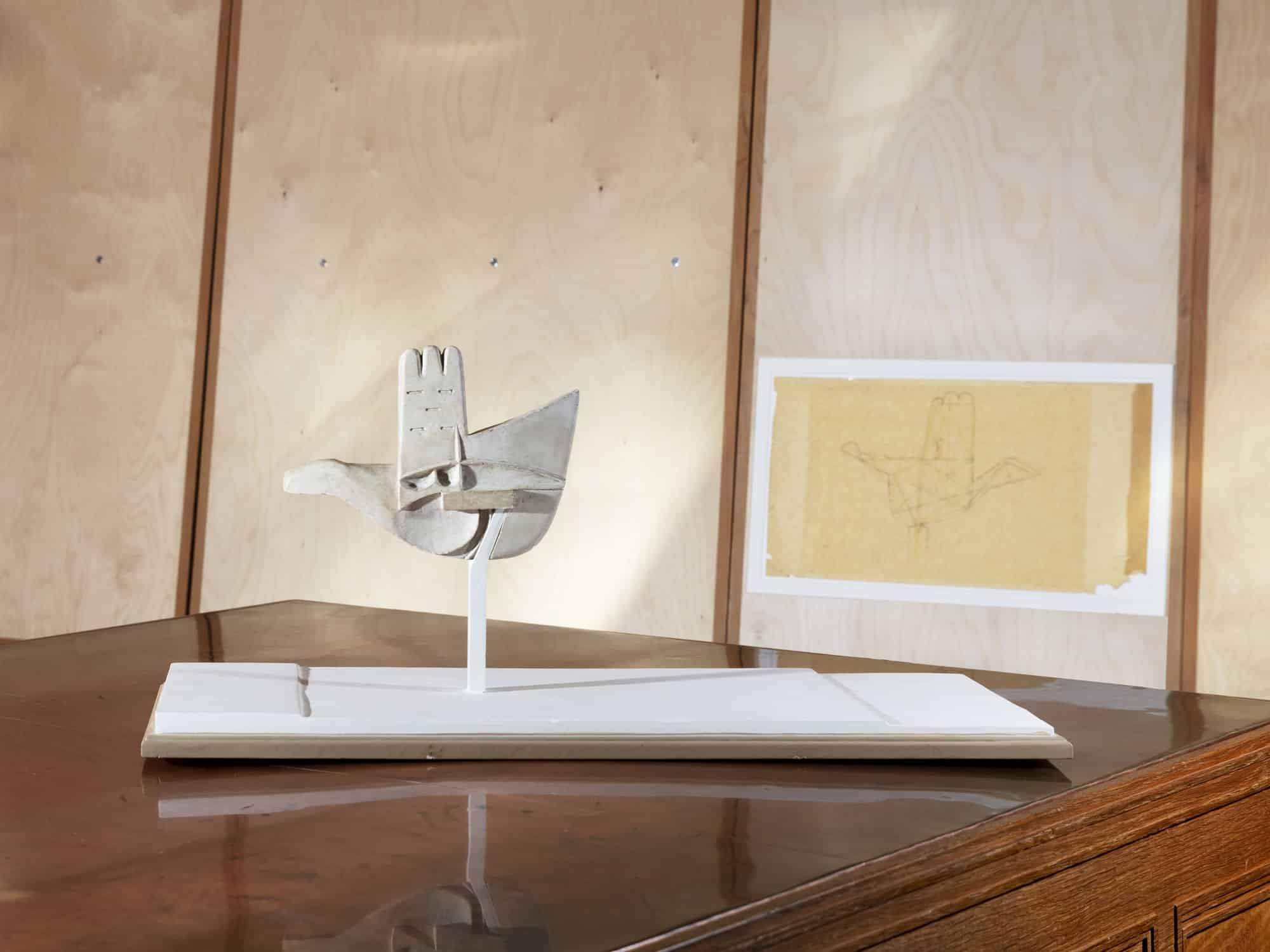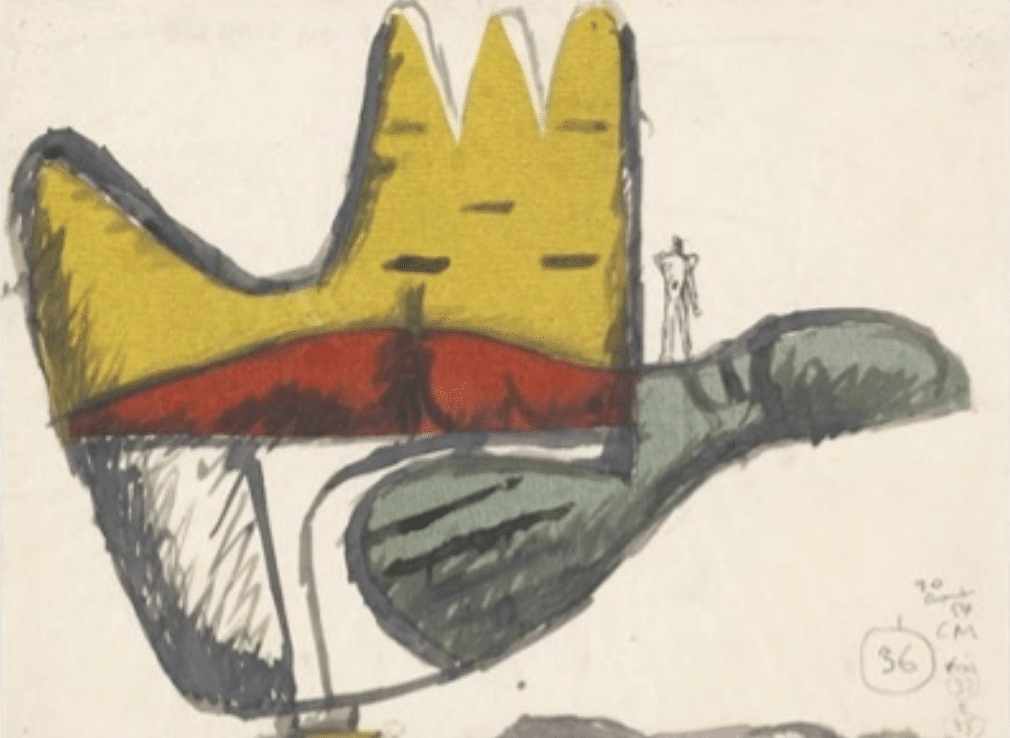Le Corbusier: The ‘Open hand’ as an expression of freedom?
Le Corbusier placed particular emphasis on the notion of freedom. In Où en est l’architecture?, he declares: ‘I accept a poem only if it is made of “words in freedom”’. [1] In the same text, Le Corbusier describes his conception of art as ‘individual manifestation of freedom’. [2] In Sur Les Quatres Routes in 1941, he refers to the ‘complex game whose goal is individual freedom’. [3] In the fourth volume of his Œuvre complète in 1946, he poses the question: ‘Contemporary disaster or complete spatial freedom?’. [4] And, in a text written in 1965, included in the eighth volume of Le Corbusier’s Œuvre complète, he writes: ‘This Open hand, symbol of peace and reconciliation is to be erected in Chandigarh. This emblem which has haunted my thoughts for many years ought to exist to bear witness that harmony is possible among men.’ [5]
It is thought-provoking to relate Le Corbusier’s interest in freedom
to the impact that Albert Camus’ view in L’homme revolté had on his thought. [6] On 10 October 1952, Le Corbusier sent his ‘Poème de l’angle droite’ letter to Albert Camus. [7] L’homme revolté by Albert Camus was published in 1951, two years after La Part maudite by Georges Bataille. [8] Both books were sent to Le Corbusier by their authors. Camus’ dedication in La Chute [9] reads: ‘à Le Corbusier, maître de l’angle droit, cette spiral, amicalement A. C.’ [10] Le Corbusier had in his personal library the following books by Albert Camus: L’exil et le royaume, L’homme revolté, La Chute, and La Peste. [11, 12] Among them, L’exil et le royaume and La Chute include dedications by the author.

Le Corbusier highlighted many passages in L’homme revolté, and, as becomes evident in his annotations in the book, was fascinated by it. By the notes he took on 13 November 1952 in his copy of Camus’ L’homme revolté, conserved at the Fondation Le Corbusier in Paris, we can see that Le Corbusier was particularly interested in the chapter devoted to absolute affirmation. More specifically, he highlighted a passage that analyses the relationship of Nietzsche’s theory with Presocratic thought. He also highlighted the following passage, which can help us grasp the idea behind his concept of the ‘Open Hand’: ‘No judgment accounts for the world, but art can teach us to repeat it, as the world repeats itself throughout the eternal returns.’ [13]
Manfredo Tafuri drew on Georges Bataille’s work to interpret Le Corbusier’s late work. [14] Le Corbusier met Bataille through the journal L’Esprit Nouveau, and later through the journal Minotaure, formed in 1933, where Le Corbusier published ‘Louis Soutter, L’inconnue de la soixantaine’ in 1936. [15] In 1949, Bataille published La Part maudite, which is an inquiry into the nature of civilization. [16] In the book, Bataille focuses on the concept of excess. For him, civilization reveals its order most clearly in the treatment of its surplus. The concept of surplus in Bataille’s thought could be related to Le Corbusier’s concept of ‘The Open Hand’. Bataille, in The Accursed Share, refers to ‘The Marshall Plan’. [17] Nadir Lahiji, in ‘The Gift of the Open Hand: Le Corbusier Reading Georges Bataille’s “La Part Maudite”’, remarks that, ‘[o]n the last page of this copy, Le Corbusier wrote “19 Nov. 1953”, which indicates the date he finished reading the book.’ [18] A question that arises is the extent to which Le Corbusier’s reading of Bataille’s The Accursed Share is related to Le Corbusier’s concept of ‘The Open Hand’. I argue here that Le Corbusier’s concept of the ‘The Open Hand’ could be related to the following passage of La Part maudite highlighted in his own copy:
In this perspective of man liberated through action, having effected a perfect adequation of himself to things, man would have them behind him, as it were; they would no longer enslave him. A new chapter would begin, where man would finally be free to return to his own intimate truth, to freely dispose of the being that he will be, that he is not now because he is servile. [19]
Le Corbusier saw ‘The Open Hand’ as his only political gesture. This becomes apparent in a letter addressed to Eugène Claudius-Petit on 14 September 1962:
I have never been in politics—while respecting those who are in it—the
good ones. I’ve had a political gesture, that of the Open Hand, the day
one of the two parties that divide the world for the sake of two different
natures forced me to take side, following a moral obligation. [20]

As Jean-Louis Cohen suggested in his talk ‘The Art of Zigzag: Le Corbusier’s Politics’, ‘Le Corbusier had been able to manipulate in an extremely clever way the meaning of “The Open Hand”’. Cohen claims that ‘[i]nitially, the hand was clearly the hand the communists handed out to the Catholics and this was clear to everybody in French politics. By rotating and giving it two faces, a sort of strange hand, which has a front and maybe another front on the other side’. [21] Neutralising communist connotations in ‘The Open Hand’ permitted Le Corbusier to introduce it into a post-war humanistic discourse context. Le Corbusier’s Open hand could be interpreted as a gesture that aimed to express his views concerning freedom and architecture as liberating action.
Extracted, with permission, from Drawing and Experiencing Architecture: The Evolving Significance of City’s Inhabitants in the 20th Century by Marianna Charitonidou, published by Transcript Verlag and available here.
Notes
- Le Corbusier, ‘Où en est l’architecture?’, in Jean Badovici, ed., L’architecture vivante (Paris: Editions Albert Morancé, 1927), pp.7–11.
- Ibid.
- Le Corbusier, Sur les Quatres Routes (Paris: Fondation Le Corbusier and Éditions Denoël, 1970), p.15, 26, 153; Le Corbusier, Sur les 4 routes (Paris: Gallimard, 1941).
- Willy Boesiger, ed., Le Corbusier, Œuvre complète, 1938–1946 (Zurich: Les Éditions d’architecture, 1946).
- Boesiger, ed. Le Corbusier. Les dernières Œuvres. The Last Works. Die letzten Werke, vol. 8 (Zurich: Les Éditions d’Architecture Artemis, 1973).
- Camus, L’homme revolté (Paris: Gallimard, 1951), p.97; Camus, The Rebel: An Essay on Man in Revolt, foreword Sir H. Read, revised and translated by A. Bower (New York: Vintage Books, 1956).
- Le Corbusier, letter sent to Albert Camus, 10 October 1952, Fondation Le Corbusier, Paris, FLC B3-7-489.
- Bataille, La part maudite, essai d’économie général, la consumation (Paris: Les Éditions Minuit, 1949); Bataille, The Αccursed Share: an Εssay on General Economy (New York: Zone Books, 1988).
- Albert Camus, La Chute (Paris: Gallimard, 1956); Camus, The Fall, translated by Justin O’Brien (Penguin: Harmondsworth, 1963).
- From the personal library of Le Corbusier that is conserved in Fondation Le Corbusier in Paris.
- Camus, L’exil et le royaume (Paris: Gallimard, 1957); Camus, Exile and the Kingdom (London: Penguin, 2013).
- Camus, La peste (Paris: Gallimard, 1947); Camus, The Plague (London: Penguin, 1998).
- Camus, L’homme revolté; Camus, The Rebel: An Essay on Man in Revolt.
- Manfredo Tafuri, ‘Machine etmémoire: The City in The Work of Le Corbusier’, in Harold Allen Brooks, ed., Le Corbusier (Princeton, NJ.: Princeton University Press, 1987); Tafuri, ‘Machine et mémoire: la ville dans l’œuvre de Le Corbusier’, in Le Corbusier, une encyclopédie (Paris: éditions du Centre Pompidou – CCI, 1987); Tafuri, ‘Machine et mémoire: La città nell’opera di Le Corbusier’, Casabellà, 502 (1984), pp.44–51.
- Le Corbusier, ‘Louis Soutter, L’inconnue de la soixantaine’, Minotaure, 9 (1936).
- Bataille, La Part Maudite, essai d’économie général,la consumation; Bataille, The Αccursed Share: An Εssay on General Economy.
- The official name of Marshall Plan, which was in operation for four years starting on 8 April 1948, is European Recovery Program. The Soviet Union refused Plan benefits, and also blocked benefits to Eastern Bloc countries, such as East Germany and Poland. From the outset, the Marshall Plan tended toward a rising of the standard of living world-wide. See Michael Holm, The Marshall Plan: A New Deal for Europe (Oxon; New York: Routledge, 2017).
- Nadir Lahiji, ‘The Gift of the Open Hand: Le Corbusier Reading Georges Bataille’s “La Part Maudite”’, Journal of Architectural Education, 50 (1) (1996), pp.50–67.
- Bataille, The Αccursed Share: An Εssay on General Economy.
- Le Corbusier, letter sent to Eugène Claudius-Petit, 14 September 1962, Fondation Le Corbusier, Paris.
- Jean-Louis Cohen, ‘The Art of Zigzag: Le Corbusier’s Politics’, lecture delivered at Harvard University’s GSD on 25 February 2016.

– Danièle Pauly